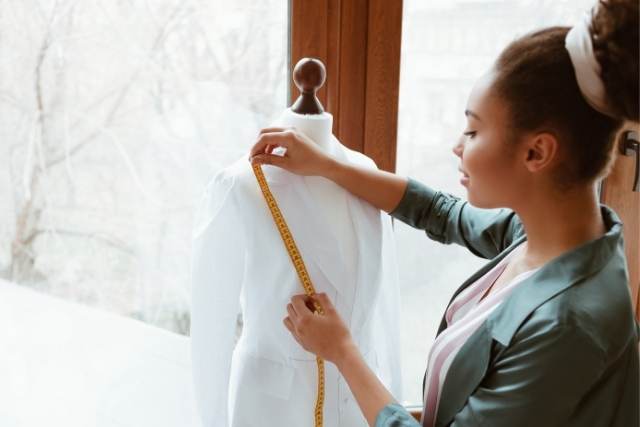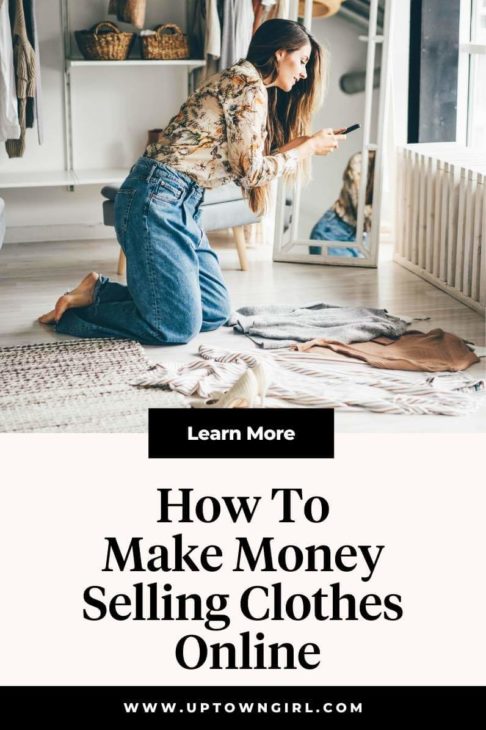Sell Clothes Online and Earn Money: The Ultimate Guide

Erika Marie is a fashion and beauty writer as well…
Once you’ve purged old items from your wardrobe, you may consider selling your pre-loved clothes and accessories on one of the many reseller apps. One girl’s trash is another girl’s treasure, and that treasure can earn you enough cash to pay a few bills or invest in a new wardrobe. Here’s a comprehensive guide of the best tips and tricks on how to sell clothes online the right way and make top dollar.
1. Inspect and Prep the Goods
Before you list your items, you want to inspect each piece for any flaws. Are there stains, missing buttons, or broken zippers? Consider repairing items first if you have sewing skills. Customers may not mind imperfections, but garments with holes and rips may not be worth selling.
What about your white blouse with the mustard stain that won’t budge? Toss it. For all other garments, throw them in the laundry so they look new and fresh.
Use a cleaning cloth to wipe dirt and grime off of shoes. A product like Mr. Clean Magic Eraser is great for removing scuff marks.
Pro tip: Baby wipes work well on deodorant stains. Simply swipe the area and launder as usual.
2. Check comps
What are your items really worth? Open your favorite resell app and search for items similar to those you’d like to sell. If the app includes the ability to search sold listings, look there, too. This practice is known as checking comps, which is short for comparable analysis.
Before settling on a price, you want to remain realistic. That dress you paid $250 for two years ago may only fetch $50 today. Price your items competitively so they won’t sit online forever, but don’t price so low that you’re practically giving them away. Most platforms charge listing and final value fees that will chip away at your profit.
Pro tip: Give yourself a little wiggle room if you want to negotiate offers with potential buyers.
3. Photograph your merchandise
It’s unlikely you have a mannequin at your disposal, but you can still take great photos. You don’t need any fancy equipment. Most smartphones offer image quality that rivals some DSLR cameras.
A wooden hanger hung on a white wall is a simple and efficient way to display your goods or a white foam poster board for a flat lay background. Foam boards can be found at most dollar stores.
The key to amazing photos is lighting. Set up your makeshift photo studio next to a window so your products can receive proper lighting.
Because customers cannot touch or inspect your items in person, photos are important. The more images you provide, the more you increase your chance of selling.
Get photos of the front and back of your garment. Take close-up shots of details and fabric prints, and brand labels. Don’t forget to document each and every imperfection.
For consistency, consider taking all your photos in square mode.
What about selfies? If you feel comfortable modeling your garments, go for it. However, make sure you can still photograph your garments from all angles. You may want to consider including some flat lay images, too.
When selling shoes, photograph the soles to show off any wear. Selling a handbag or wallet? Photos of the interior are just as important as the exterior.
If your images need a little oomph, download a photo editing app such as Adobe Lightroom to make edits.
Pro tip: Avoid the use of any photo filters. Shoppers are interested in the true colors of your items and filters can distort them.
4. Measurements
Measuring your items is a necessary evil to sell clothes online. Garment sizes are not uniform across manufacturers and a size large in one brand can be small in another. Including measurements is an extra step but it can get your items sold quicker and avoid customer returns.
You need a tape measure which can be found in most discount and dollar stores.
Pro tip: Consider including your measurements in both inches and centimeters if you plan to sell clothes online internationally.
Measuring garments:
The most important measurements are the bust, total length, sleeve, waist, and hips.
Bust: Lay the tape measure from armpit to armpit, then double the number. A measurement 17 inches across, then becomes 34 inches.
Length: Measure from the top of the garment to the bottom.
Sleeve length: Measure from the shoulder to the end of the sleeve.
Waist: Measure across the garment’s natural waist, then double the number.
Hips: The natural hip line should start approximately 7 to 8 inches below the waistline. Measure from seam to seam, then double the number.
Measuring shoes:
Length: Place shoes on a flat surface, then measure from the tip of the shoe to its heel.
Width: To get the shoe’s width measurement, place the measuring tape on the widest part of the shoe all the way to the other side.
Height: If your shoes have heels you need to get the shoe’s height. Position the shoe right-side up on a flat surface. Hold the measuring tape from the bottom of the heel to where the heel is attached to the shoe.
Measuring jewelry:
Necklaces: Unclasp the necklace and lay it on a flat surface. Measure the length from end to end, rounding up to the nearest inch or centimeter.
Earrings: The length is measured from top to bottom, including the clasp. The width is measured at the widest point.
5. Write a description
Your product title helps customers find your merchandise. Include keywords you know people are searching for such as brand, color, style, and size.
Example:
BrandX Pink Floral Wrap Dress Boho Juniors Medium
The key factors that make up your product description are color, fabric content, silhouette, and style aesthetic.
Add any details that may not be obvious to the shopper. Is your dress lined? Does it come with a belt? This is where you want to include your measurements and detail any flaws.
Keep your description concise. You can use bullet points to simplify the process.
Example:
Floral mini wrap dress by BrandX. Size small. Like new condition. No stains, rips, or tears.
- Short sleeve
- V-neck
- Belt included
- Lined
- Polyester
- Length: 50 inches
- Bust: 34 inches
- Waist: 26 inches
- Hips: 32 inches
6. Customer service
Once you have items listed you may receive questions from shoppers asking for more details. Answer as quickly as you can as you do not want to lose a potential customer. Be courteous, even when they ask questions in which the answers can be found in the product description.
7. Pack your orders
The easiest way to ship your items is Priority Mail via USPS. The Postal Service offers free Priority Mail supplies that can be shipped right to your door.
Priority Mail Flat Rate makes it simple if you don’t have access to a shipping scale. Rates are determined by the size of the package. This is attractive to most buyers because heavy garments that can fit in a Priority Mail box can be cheaper than sent by First Class mail.
Fold your items neatly, then wrap them in white tissue paper before placing them in the package. Tissue paper can be purchased at dollar stores. When selling jewelry, consider wrapping them in bubble wrap to help protect them in transit.
Pro tip: Some apps suggest including thank you notes or free gifts with your packages. While this is a nice gesture, it can be time-consuming and eat into your profits.
Reselling apps
Now that you know how to sell, let’s discuss where to sell. There is no shortage of apps to sell clothes online. We’ll walk you through the most common marketplaces, their strengths, and their weaknesses.
Pro tip: You may want to consider using multiple apps to sell your items faster. Just remember to delete your items across different platforms once they sell.
eBay
The OG of resale sites, eBay is one of the most popular sites to sell clothes online. Their Seller Hub offers some of the best analytics of any marketplace so you can make the most of your data.
Pros
- Active customer base with over 150 million active users worldwide
- At least 200 zero insertion fee listings per month
Cons
- Brand new accounts are limited to selling only a few items at a time
- 12% final value fee in the clothing and accessories category
Mercari
Originally from Japan, Mercari is a selling app that has quickly gained traction in the resale market. Clothing is one of its most popular categories.
Pros
- Fairly easy to use
- No listing fees
- Discounted shipping rates
Cons
- Haggling is encouraged
- Lower traffic than other marketplaces
- No ability to bundle listings for buyers
Poshmark
A mix of a selling app and social media, Poshmark is a popular resale app. There are no listing fees. However, you will pay Poshmark 20% of your sales of $15 or more, so price your items according. Your collection is known as your Poshmark closet.
Pros
- Beginner-friendly
- An active sales base
Cons
- Beginner-friendly
- No direct messaging feature between users
- Sharing, liking, and following users can be time consuming and repetitive
Depop
Depop is a resale app that’s especially popular with millennials and generation Z. With its Instagram-like interface, well-photographed items perform well.
Pros
- No listing fees
- Video and photo features for listings
- Choose shipping rates based on item size and weight
Cons
- Lots of lowball offers
- Smaller user base
thredUP
thredUP is an online consignment store that does all the work for you. Just ship your gently used items off to thredUP and they will price, photograph, ship, and send your payout. Check their list to make sure they accept the brands you want to sell before you ship.
Pros
- No photographing, shipping, or description writing
- thredUp will send a free kit you can use to ship your clothing
Cons
- Zero control over pricing
- It may take time for items to sell
- Requesting your items to be returned costs money
Conclusion
Great photos and detailed product descriptions are all essential to sell clothes online successfully. With some extra effort, your listings can fetch the most money and outshine the competition.
Once you get the hang of it, selling clothing online can even lead to a regular side hustle that can help you buy new clothes, pay off debt, or even pay for your next vacation. Now that you know the blueprint to what makes an amazing seller, go out and earn some money!
Save the image below to Pinterest so you can come back later!
Erika Marie is a fashion and beauty writer as well as a hardcore vintage clothing enthusiast. In her free time, she can be found thrifting for hidden gems to add to her collection.













